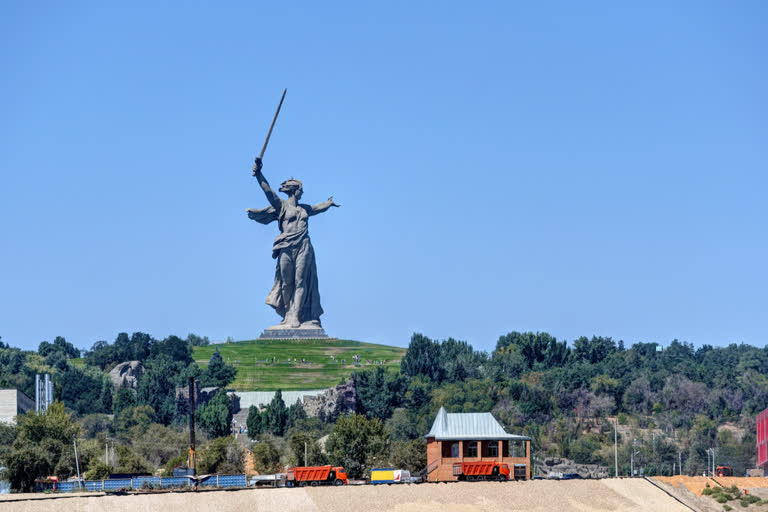Kyiv: 'The Motherland Calls,' is Europe's tallest statue, an 85-meter (278-foot) figure of a sword-wielding woman, soaring above the city Russian of Volgograd.
Completed in 1967 after eight years of construction, it is the centrepiece of a memorial complex for the Battle of Stalingrad the city's former name - in which some two million people died, as Soviet soldiers repulsed Nazi armies.
Massive statues and monuments At her feet, lie the remains of approximately 35 thousand unidentified soldiers, who defended the city.
The statue officially re-opened on May 9, after a three-year facelift.
Vladimir Antonov, head of the restoration project, explains the challenges.
"The flowing cloak is many tons of concrete floating in the air," he says.
"We needed to put around it wood (scaffolding) so that workers and renovators could reach each point of the monument to conduct quality restoration."
Renovations were needed to repair cracks in the concrete and to apply a weatherproof coating around the statue, he adds.
The Soviet Union's suffering and valour during the Second World War have become a fundamental part of Russia's national identity.
Few Russians are far from a memorial, whether it's one that's huge and demands attention or one that's so modest and quiet that it can easily be missed.
Read more:World marks 6th International Yoga Day despite COVID-19 curbs
"Everywhere you go, there is a monument of Great Patriotic War," explains Scott Palmer, PhD. Professor and Chair of the Department of the History at the University of Texas.
On the outskirts of Belarus capital, Minsk is an open-air memorial complex, called the Mound of Glory.
It was built in 1969 to mark the 25th anniversary of the liberation of Belarus and honours soldiers who sacrificed their lives during the Second World War.
Soil for the memorial was brought from nine cities around the Soviet Union as well as from battlefields.
Belarus suffered tremendously during the war, by various estimates almost one-third of its population died.
Nazi occupation of Belarus began on June 22, 1941, and lasted until August 1944.
Monuments gave people comfort, says Palmer.
"27 million people just lost their lives. It was a horrific calamity, really unprecedented, certainly in modern history, if not in world history. The loss of life that the peoples of the Soviet Union suffered," he says.
Also read:Indonesia's most volatile volcano spews ash
"You have to find some way of trying to make meaning out of that, and the creation of a memorial and the birth of this cult of the Great Patriotic War was an attempt, yes, to serve propaganda functions and to rally people around the party (communist party), but it also serves a larger need."
One of the most powerful and symbolic monuments of WWII is the Tomb of the Unknown Soldier, located at Moscow's Kremlin Wall.
The remains of the unknown soldier were relocated from a mass grave in 1966 to mark the 25th anniversary of the Battle of Moscow that started in 1941.
In front of the tomb are an eternal flame and an inscription that reads: "Your name is unknown, but your deeds are immortal". Guards are always present at the site.
Historians agree that these monuments served a double purpose they celebrated the heroism of soldiers, but at the same time, were used as propaganda for the Soviet Communist Party.
Tetiana Tastushenko, a research associate at the Institute of History of Ukraine, says such monuments served as a reminder of the authority of the Soviet Empire.
The Motherland Monument is one of the landmarks of Ukraine's capital, Kyiv.
It's a giant sculpture of a woman with a shield and a sword in her hands. It symbolizes the heroism of people during the war.
Unveiled in 1981, the statue has an overall height of 102 meters, comprising of a 40-meter pedestal and a 62-meter statue, towering over the Dnieper River.
Also read:Enthusiasts mark International Yoga Day in Kabul
(With inputs from AP)
